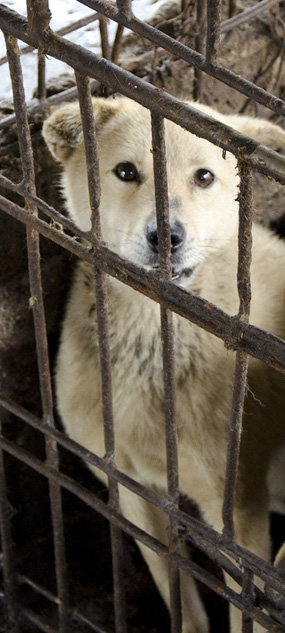


On my first day investigating the dog meat industry in China, we visited the Guangzhou Jinrong Livestock Wholesale Market, where animals, who would later end up as meat on someone’s plate, were being sold to the highest bidder.
I observed sections of dogs, goats, pigs and donkeys on this market. When I arrived, people were unloading pigs from trucks – the same trucks we had previously seen on the highway. The pigs were packed in tightly in barred metal cages. The bottom level of pigs could barely stand up and the animals’ backs were rubbing on the second level. Some were reduced to kneeling down on the hard floor. The animals appeared exhausted and their demeanor was weary. They had dark shadows around bloodshot eyes. The animals appeared exhausted and their demeanor was weary. The people on the market carried out their work apparently oblivious to the suffering of animals there. And oblivious to the injuries, fear and screams.
To unload the pigs from the trucks, the workers used iron bars to hit the animals. I observed many animals being hit directly in and between their eyes. The workers didn’t seem to care, and sometimes laughed at the animals’ screams and falls as they struggled to remove themselves from the bars.
At the other end of the yard was the gated dog area. In front of the dog area there were piles of iron cages – apparently typical of cages used to transport these animals. I was unable to take many pictures in this area as the guard stopped me. When I reached out to the dogs with my hands, they were surprisingly curious and stretched to reach me. These animals can be the best friends of humans, which makes this trade even more confusing. Yet these individuals had become no more than victims of the meat industry.
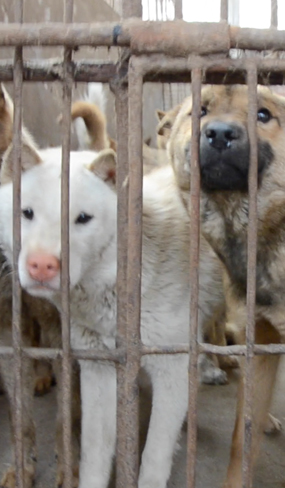
I drove approximately one hour from Guanzhou North. The market was quite typical, with some animals, mainly chickens and ducks, being sold openly. I identified the area where cats and dogs were being sold and I was able to film openly there. Both cats and dogs were held in small iron cages. Movement was difficult for these animals, who were forced into cramped positions.
They were not aggressive, but very scared and cautious of people who approached their iron cages.
Unlike the dogs for sale on the Guangzhou Jinrong Livestock Wholesale Market, all of the animals here I observed gave the impression of total submission. They were not aggressive, but very scared and cautious of people who approached them.
The cats lay on top of each other, trying desperately to find some comfort amongst their companions.
I really had the impression that these beings felt that their life was in great danger, and that their only way to escape a deadly fate was to beg humans for some mercy.
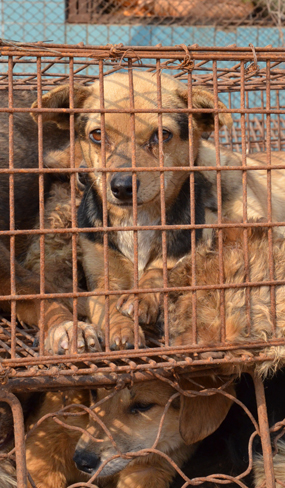
Although it is consumed all year round, in the summer months, people consume the most dog meat. People can purchase dog meat in small markets, along with chicken and pork, and there are also small and large dog meat restaurants on the streets.
I arrived at the animal market when it was already almost noon. Most of the animals sold here were birds (chickens, ducks and geese).
I saw dogs trapped in small metal cages. Again, the dogs were extremely submissive and showed no aggression when people approached the cages. I never saw anyone providing the animals with water while they were held for hours in the cages.
The cats were cramped also in cages, lying on top of each other. The animals were filthy with their own excrement, and the excrement of their cage mates. This meant the cages had a strong stench. I never saw anyone providing the animals with water while they were held for hours in the cages. I asked a cat seller how much the cat meat was being sold for. He told me that it was 8 RMB (1 Euro) per 500 grams.
I never saw anyone providing the animals with water while they were held for hours in the cages.
I noticed that some of the dogs and puppies were wearing collars. When I asked why a German Shepherd-type dog was wearing a collar, the stall holder told me that it was his dog, yet this animal was also caged alongside the other dogs. The stallholder opened the cage to show me the dog, who cowered in fear. I’m guessing he told us it was his dog so that we wouldn’t think he was someones pet who had been kidnapped to be sold as dog meat. On top of the cage lay a blood-stained wooden stick which was likely to have been used to kill dogs in front of cage mates. On the ground in front of the cage was a spot of fresh blood.
Some dogs were observed running free in alleyways. Others were chained. I was told that these dogs were not for human consumption, and were peoples’ “pets”. But what is the difference between these individuals and the dogs in cages who would soon be killed? On what criteria do humans decide who should be caged and eventually eaten, and who should be spared and kept as a member of the family?
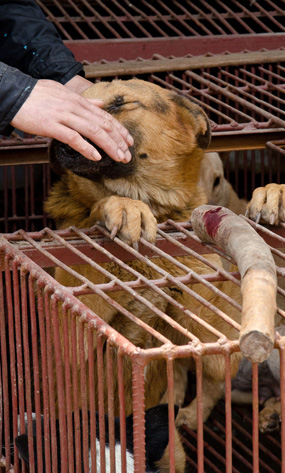
Upon arrival at a dog farm located in the suburb of Diangbei, I observed caged dogs. However the animals here were apparently not to be sold for their flesh, but for pets.
I could not see anything that could possibly provide the animals with any comfort.
There were a couple of larger and smaller dogs within tiny cages. One of these animals looked quite old. Many of the dogs were German Shepherds.
The dogs were barking alot when I stood near to the cages.
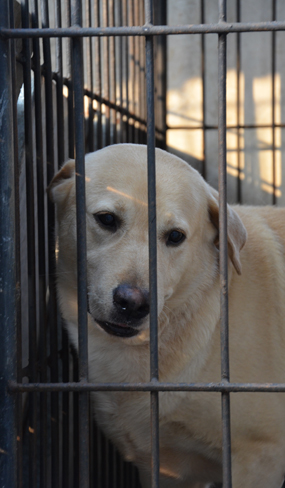
The city of Zhanjiang is famous for the sale of dog meat. Around a third of the restaurants in this city sell it.
I arrived in Zhanjiang when it was dark. Many people were walking the streets and dining in street restaurants. Down one of these streets, I located several restaurants selling dog meat.
At the front of the restaurants were stalls with the corpses of dead dogs on. The throats of the dogs were covered in large lateral gashes.
The meat they swallowed certainly didn’t look any different than the meat of other animals, like pigs or cows.The dogs had terrified facial expressions and, because their bodies had been boiled in water, their skin had shrunk, which meant that their teeth were showing.
Restaurant customers eating dog meat who saw me taking photographs started smiling and making friendly gestures. They asked to be photographed eating dog meat and appeared proud of their culinary choice. These people eating dog meat are just the same as someone in Europe eating a steak. The meat they swallowed certainly didn’t look any different than the meat of other animals, like pigs or cows; it becomes dark after being cooked, and you can recognise what it’s made of: muscles, tendons, bones… It is the flesh of a sentient being who wanted to live life in peace and was killed for the futile reason that someone liked the taste of his or her body.
We enquired at a restaurant where the killed dogs came from and were told (by a waitress) that they came from another province. She said that the dogs were from the streets, rather than farms. Another waitress told us that the dogs came more precisely from Hunan or Sichuan. The dogs are apparently killed there, and the fresh meat is then sent to Zhanjiang.
The selling price of the dog meat was 30 or 40 RMB (3 or 4 euros) per 500g – which is relatively more expensive than meat that is sold from other types of animals.
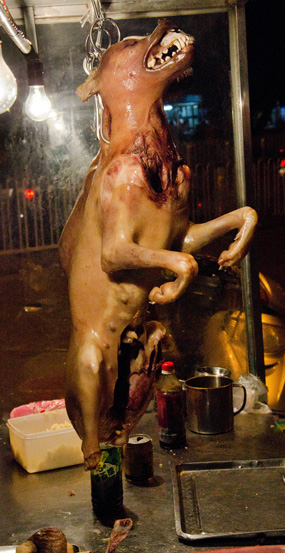
During my visit, I observed three workers on site.
There were around 100 live dogs present on site – inside the building.
Since the slaughterhouse was located inside a building and underground, we had to step down some stairs to enter. The place was extremely badly lit, and very humid. There was a serious drainage problem, and the floor was flooded from accumulated water, and water that was dripping from a tap to wash away the blood from dogs who had been stabbed.
I observed some of the dogs tried to defend themselves from the workers but their efforts were invariably in vain. There was no escape.The place was surprisingly quiet, with the only noise coming from whimpering and crying dogs who were being crushed with tongs, dragged across the floor and battered to death with sticks. Some were beaten unconscious by workers who smashed sticks across their very pain-sensitive nasal area. The workers showed no signs of compassion for the animals, who were roughly handled, punched and kicked across the room before being killed. `Workers either joked, smiled or were oblivious as they dismembered still alive and breathing dogs in full view of other dying dogs amongst the mounds of bodies on the floor.
I observed some of the dogs tried to defend themselves from the workers but their efforts were invariably in vain. There was no escape. At least two workers were present at any time – one grabbed the dogs from cages, the other battered and stabbed at the animals.
Each victim was first caught at the throat by a metal tong clenches. If they attempted to resist, by barking or baring their teeth, one of the workers pressed the tong handles down further to tighten his grip on the animal. Another worker aimed for the nose of the dogs with a wooden stick. This man was very aware of how to do it, knowing precisely which were the most sensitive parts of the dogs’ anatomy. The dogs who were semi-conscious were then stabbed in the throat with a long knife and thrown a couple of feet to where he or she would be boiled.
I observed some dogs cowering in tiny metal cages on the floor, in full view of the area where other dogs would be grabbed from the cages and killed. The caged dogs could also view bodies of dead dogs lying on the floor. They were forced to watch their companions die whilst they awaited the same fate. During the visit, around half the dogs were not battered unconscious immediately, and these animals were hung up whilst still thrashing around.
During the visit, around half the dogs were not battered unconscious immediately, and these animals were hung up whilst still thrashing around.I still have visions of these animals thrashing around in agony whilst being hung up and stabbed. I will never forget the horror in their eyes. And there was nothing I could do to help them. All I could do was record the events so that as many people as possible can witness the fate of these animals and speak out against this abuse.
These individuals were only a few of the yearly hundreds of billions victims of the meat industry, however their fear was overwhelming to me. It was clear that they wanted nothing more that to leave this hell hole.
They endured what every victim of the meat industry endures: confinement, torture, and finally murder.
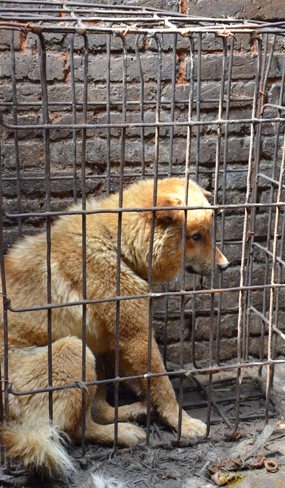
I located a dog holding center where dogs were held until they were sold to either a slaughterhouse or another buyer.
All of the dogs appeared to be exhausted, weary and withdrawn.
I observed dogs who were injured. They had open, bloody wounds, on the legs, face and throat.
These injuries were probably a result of being grabbed from the street, being beaten and thrown into cages, being bit by cage mates or being scraped against the rusted metal during their transport.
All of the dogs appeared to be exhausted, weary and withdrawn.
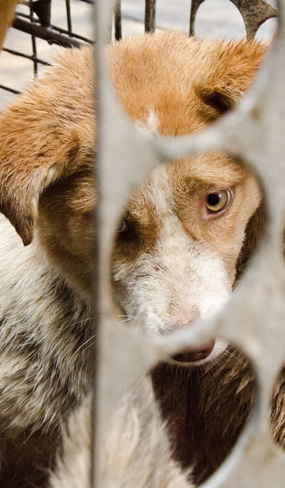
This slaughterhouse was the largest one I visited in China. There were five workers on site. A house was attached to the slaughterhouse and a dog holding area that was sectioned in two. This area reminded me of an open air prison. Each of the sections was approximately 60 m².
I was told that not all dogs who arrive are killed on the same day. They can be held in this hell hole for several days.
They can be held in this hell hole for several days.Between the entrance to the property and the dog holding area was the area where dogs were beaten to death, dismembered and boiled in water.
No killing took place while I was in the vicinity, as workers were busy preparing and cooking the corpses of dead dogs in large pans. There was a dog running free, who seemed to be a worker’s ‘pet’.
I was told that all the dogs are street dogs, caught in various cities. When I asked if the dogs were being provided with food and water during that time, I was told that they got water every once in while, but no food.
